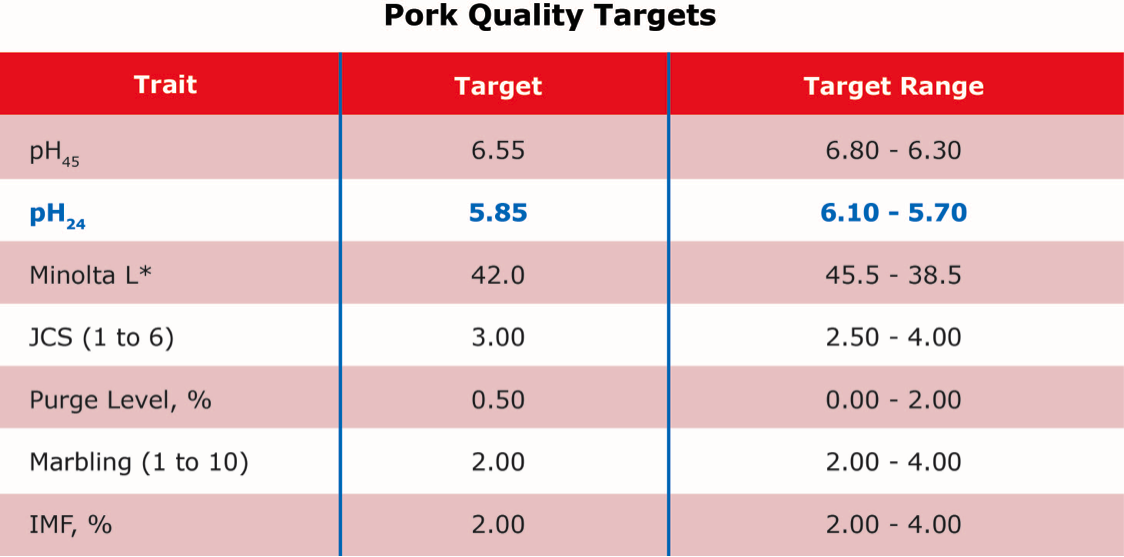



PIC Pork Quality Programme: A Quarter of Century of Progress
GLOBAL - PIC’s focus for the past 25 years has been on genetically improving and environmentally optimising factors impacting pork quality. Its goal has been to design, implement, and continuously improve a “Robust Breeding for Pork Quality“ program, focusing on meeting the needs of the entire pork supply chain (pork producers and processors, wholesalers, retailers, the food service industry and the global export markets), while ultimately fulfilling the needs of the end-user, the global consumer.Some major milestones delineating PIC’s programme to improve pork quality of our lines from 1990-2016 are summarized in the chart below.


PIC fully established targets for pork quality for the first time in 1996 (see the table below).
While closely monitoring all of the traits of practical importance, our main focus has been on measurement and selection of pedigreed pigs based on meat ultimate pH (pH is a measure of meat acidity after post-mortem conversion of muscle to meat; pH measured 24-hours post-mortem; typically the loin and/or the large ham muscles are measured). Both PIC and academic research have shown pH24 to be the best predictor of overall pork quality.
Aside from the ability to measure it in large scale and in multiple environments as part of PIC’s GNX program, pH is highly correlated (i.e. changes in pHu trigger changes in other traits) with most of the important pork quality characteristics. For instance, ultimate pork pH has a strong correlation with traits like meat color and meat firmness (i.e. higher pHu within the range of 5.75-5.90 is associated with darker and firmer meat) as well as with meat drip loss (i.e., higher pHu is associated with lower drip loss measured on a cube of meat or on a chop of packaged meat).
While setting the correct genetic improvement targets is strategically necessary, for us, the key is to achieve those strategic outcomes in commercial systems of PIC global customers. Current data shows pork (loin and ham muscles) quality of PIC progeny remains aligned with our targets and continues to meet the needs of the entire pork supply chain.

Simultaneously to developing our robust Breeding for Pork Quality Program, PIC’s technical services have been working with our customers to implement animal handling practices designed to improve the welfare of animals on farm, in transit to the processing plant, and during the pre-slaughter handling and stunning.
Furthermore, PIC assists with helping characterize and define optimal carcass chilling practices that help enhance pork quality. One of the first industry standards of animal welfare and pork quality was established by PIC in the 1990’s. This Blueprint’s initial objective was to identify a combination of practices to ensure that animals are handled and slaughtered in a humane manner, while also resulting in an improvement in meat quality – a target that we still work diligently on today.
In keeping with our motto of “Never Stop Improving”, PIC continues to actively contribute to and monitor new scientific knowledge on the biology and practical implementation of humane handling. One of PIC’s latest additions to our Total Profit Selection Objective is a ‘fitness test’ utilizing measurements of blood lactic acid (LA) level after applying a mild exercise to the breeding candidates at the Genetic Nucleus farms during off-testing. The initial scientific knowledge underlying PIC’s fitness EBV (Estimated Breeding Value) was developed by a consortium of scientists from Colorado State University, ELANCO, Hormel Foods and PIC. PIC has then developed a proprietary, practical fitness test, developed genetic parameters (heritability of blood LA level and genetic correlations with traits of economic significance such as meat ultimate pH, pig lean deposition, muscling, growth rate, feed conversion, livability), and implemented the trait in PIC’s genetic development program.
PIC has been focused on maximizing total value and return to the pork chain for over 50 years. This commitment continues to be driven by initiatives such as the Breeding for Pork Quality Program established more than 25 years ago.
This program, fully supported by PIC Technical Services working closely with our customers on optimizing animal welfare and pork quality environmental standards, ensures that PIC’s customers continue to lead the pork supply chain globally in producing a high-quality, sustainable and efficient product for today and tomorrow.








